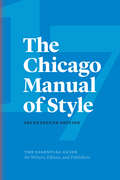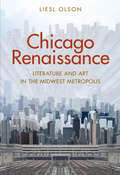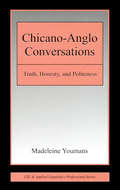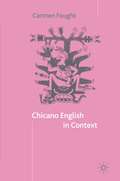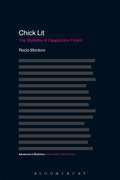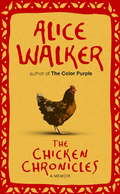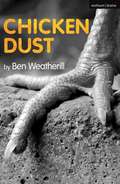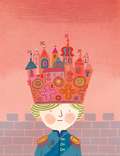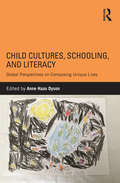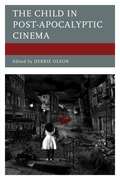- Table View
- List View
The Chicago Manual of Style, 17th Edition
by The University of Chicago Press Editorial StaffTechnologies may change, but the need for clear and accurate communication never goes out of style. That is why for more than one hundred years The Chicago Manual of Style has remained the definitive guide for anyone who works with words. In the seven years since the previous edition debuted, we have seen an extraordinary evolution in the way we create and share knowledge. This seventeenth edition of The Chicago Manual of Style has been prepared with an eye toward how we find, create, and cite information that readers are as likely to access from their pockets as from a bookshelf. It offers updated guidelines on electronic workflows and publication formats, tools for PDF annotation and citation management, web accessibility standards, and effective use of metadata, abstracts, and keywords. It recognizes the needs of those who are self-publishing or following open access or Creative Commons publishing models. The citation chapters reflect the ever-expanding universe of electronic sources—including social media posts and comments, private messages, and app content—and also offer updated guidelines on such issues as DOIs, time stamps, and e-book locators. Other improvements are independent of technological change. The chapter on grammar and usage includes an expanded glossary of problematic words and phrases and a new section on syntax as well as updated guidance on gender-neutral pronouns and bias-free language. Key sections on punctuation and basic citation style have been reorganized and clarified. To facilitate navigation, headings and paragraph titles have been revised and clarified throughout. And the bibliography has been updated and expanded to include the latest and best resources available. This edition continues to reflect expert insights gathered from Chicago’s own staff and from an advisory board of publishing experts from across the profession. It also includes suggestions inspired by emails, calls, and even tweets from readers. No matter how much the means of communication change, The Chicago Manual of Style remains the ultimate resource for those who care about getting the details right.
Chicago of the Balkans: Budapest in Hungarian Literature 1900-1939
by Gwen JonesAt the point of its creation in 1873, Budapest was intended to be a pleasant rallying point of orderliness, high culture and elevated social principles: the jewel in the national crown. From the turn of the century to World War II, however, the Hungarian capital was described, variously, as: Judapest, the sinful city, not in Hungary, and the Chicago of the Balkans. This is the first English-language study of competing metropolitan narratives in Hungarian literature that spans both the liberal late Habsburg and post-liberal, 'Christian-national' eras, at the same time as the 'Jewish Question' became increasingly inseparable from representations of the city. Works by writers from a wide variety of backgrounds are discussed, from Jewish satirists to icons of the radical Right, representatives of conservative national schools, and modernist, avant-garde and 'peasantist' authors. Gwen Jones is Hon. Research Associate at the Department of Hebrew and Jewish Studies, University College London.
Chicago of the Balkans: Budapest in Hungarian Literature 1900-1939
by Gwen JonesAt the point of its creation in 1873, Budapest was intended to be a pleasant rallying point of orderliness, high culture and elevated social principles: the jewel in the national crown. From the turn of the century to World War II, however, the Hungarian capital was described, variously, as: Judapest, the sinful city, not in Hungary, and the Chicago of the Balkans. This is the first English-language study of competing metropolitan narratives in Hungarian literature that spans both the liberal late Habsburg and post-liberal, 'Christian-national' eras, at the same time as the 'Jewish Question' became increasingly inseparable from representations of the city. Works by writers from a wide variety of backgrounds are discussed, from Jewish satirists to icons of the radical Right, representatives of conservative national schools, and modernist, avant-garde and 'peasantist' authors. Gwen Jones is Hon. Research Associate at the Department of Hebrew and Jewish Studies, University College London.
Chicago Renaissance: Literature and Art in the Midwest Metropolis
by Liesl OlsonA fascinating history of Chicago’s innovative and invaluable contributions to American literature and art from the late nineteenth to the mid-twentieth century This remarkable cultural history celebrates the great Midwestern city of Chicago for its centrality to the modernist movement. Author Liesl Olson traces Chicago’s cultural development from the 1893 World’s Fair through mid-century, illuminating how Chicago writers revolutionized literary forms during the first half of the twentieth century, a period of sweeping aesthetic transformations all over the world. From Harriet Monroe, Carl Sandburg, and Ernest Hemingway to Richard Wright and Gwendolyn Brooks, Olson’s enthralling study bridges the gap between two distinct and equally vital Chicago-based artistic “renaissance” moments: the primarily white renaissance of the early teens, and the creative ferment of Bronzeville. Stories of the famous and iconoclastic are interwoven with accounts of lesser-known yet influential figures in Chicago, many of whom were women. Olson argues for the importance of Chicago’s editors, bookstore owners, tastemakers, and ordinary citizens who helped nurture Chicago’s unique culture of artistic experimentation.Cover art by Lincoln Schatz
Chicana/o Subjectivity and the Politics of Identity: Between Recognition and Revolution
by C. GallegoThis book traces the influence of Hegel's theory of recognition on different literary representations of Chicano/a subjectivity, with the aim of demonstrating how the identity thinking characteristic of Hegel's theory is unwillingly reinforced even in subjects that are represented as rebelling against liberal-humanist ideologies.
Chicano-Anglo Conversations: Truth, Honesty, and Politeness (ESL & Applied Linguistics Professional Series)
by Madeleine YoumansThis groundbreaking book--about differences in communication practices between Mexican-American underclass residents in an East Los Angeles housing project and white, middle-class literacy tutors who worked with them--makes an important contribution to research on the sociolinguistics of the Chicano gang culture. More specifically, this work adds substantially to research on understanding linguistic politeness theories, the use of epistemic modals for negative politeness, and evidentiality. It refines, and in a number of cases, defines, function categories for epistemic modals through a rigorous grammatical analysis. This book is also distinctive in that the author subjects the language of middle-class Anglos to the same type of scrutiny that is often reserved for non-mainstream groups. Youmans contends that the differences between the Chicano and Anglo speakers are the result of the two groups’ different sociocultural circumstances, including historical and current living and working patterns and the relative value placed on familialism and communalism versus individualism and independence. (The terms Chicano and Anglo are used as a kind of shorthand in this book--not to raise larger sociocultural issues implied by these terms.) Although the number of participants in the study limits the applicability of the findings as they might be extrapolated to all Chicanos/as, or all Anglos when reporting sociolinguistic observations, the main argument advanced is that language use may provide insights into beliefs, attitudes, and practices in the larger society. This volume is directed to researchers and graduate students in the areas of sociolinguistics, applied linguistics, discourse analysis, and cross-cultural communication, and will also interest language and linguistics educators and grammarians.
Chicano-Anglo Conversations: Truth, Honesty, and Politeness (ESL & Applied Linguistics Professional Series)
by Madeleine YoumansThis groundbreaking book--about differences in communication practices between Mexican-American underclass residents in an East Los Angeles housing project and white, middle-class literacy tutors who worked with them--makes an important contribution to research on the sociolinguistics of the Chicano gang culture. More specifically, this work adds substantially to research on understanding linguistic politeness theories, the use of epistemic modals for negative politeness, and evidentiality. It refines, and in a number of cases, defines, function categories for epistemic modals through a rigorous grammatical analysis. This book is also distinctive in that the author subjects the language of middle-class Anglos to the same type of scrutiny that is often reserved for non-mainstream groups. Youmans contends that the differences between the Chicano and Anglo speakers are the result of the two groups’ different sociocultural circumstances, including historical and current living and working patterns and the relative value placed on familialism and communalism versus individualism and independence. (The terms Chicano and Anglo are used as a kind of shorthand in this book--not to raise larger sociocultural issues implied by these terms.) Although the number of participants in the study limits the applicability of the findings as they might be extrapolated to all Chicanos/as, or all Anglos when reporting sociolinguistic observations, the main argument advanced is that language use may provide insights into beliefs, attitudes, and practices in the larger society. This volume is directed to researchers and graduate students in the areas of sociolinguistics, applied linguistics, discourse analysis, and cross-cultural communication, and will also interest language and linguistics educators and grammarians.
Chicano English in Context
by C. FoughtChicano English in Context is the first modern, comprehensive study of Chicano English, a variety spoken by millions of Latinos in the U.S. It is also one of the first studies of ongoing sound change within an ethnic minority community. It briefly describes the phonology, syntax and semantics of this variety, and explores its crucial role in the construction of ethnic identity among young Latinos and Latinas. It also corrects misconceptions in how the general public views Chicano English.
Chicano/Latino Homoerotic Identities
by David W. FosterFirst published in 1999. Routledge is an imprint of Taylor & Francis, an informa company.
Chicano/Latino Homoerotic Identities
by David W. FosterFirst published in 1999. Routledge is an imprint of Taylor & Francis, an informa company.
Chick Lit: The New Woman's Fiction
by Suzanne Ferriss Mallory YoungFrom the bestselling Bridget Jones's Diary that started the trend to the television sensation Sex and the City that captured it on screen, "chick lit" has become a major pop culture phenomenon. Banking on female audiences' identification with single, urban characters who struggle with the same life challenges, publishers have earned millions and even created separate imprints dedicated to the genre. Not surprisingly, some highbrow critics have dismissed chick lit as trashy fiction, but fans have argued that it is as empowering as it is entertaining.This is the first volume of its kind to examine the chick lit phenomenon from a variety of angles, accounting for both its popularity and the intense reactions-positive and negative-it has provoked. The contributors explore the characteristics that cause readers to attach the moniker "chick" to a particular book and what, if anything, distinguishes the category of chick lit from the works of Jane Austen on one end and Harlequin romance novels on the other. They critique the genre from a range of critical perspectives, considering its conflicted relationship with feminism and postfeminism, heterosexual romance, body image, and consumerism. The fourteen original essays gathered here also explore such trends and subgenres as "Sistah Lit," "Mommy Lit," and "Chick Lit Jr.," as well as regional variations. As the first book to consider the genre seriously, Chick Lit offers real insight into a new generation of women's fiction.
Chick Lit: The New Woman's Fiction
by Suzanne Ferriss Mallory YoungFrom the bestselling Bridget Jones's Diary that started the trend to the television sensation Sex and the City that captured it on screen, "chick lit" has become a major pop culture phenomenon. Banking on female audiences' identification with single, urban characters who struggle with the same life challenges, publishers have earned millions and even created separate imprints dedicated to the genre. Not surprisingly, some highbrow critics have dismissed chick lit as trashy fiction, but fans have argued that it is as empowering as it is entertaining.This is the first volume of its kind to examine the chick lit phenomenon from a variety of angles, accounting for both its popularity and the intense reactions-positive and negative-it has provoked. The contributors explore the characteristics that cause readers to attach the moniker "chick" to a particular book and what, if anything, distinguishes the category of chick lit from the works of Jane Austen on one end and Harlequin romance novels on the other. They critique the genre from a range of critical perspectives, considering its conflicted relationship with feminism and postfeminism, heterosexual romance, body image, and consumerism. The fourteen original essays gathered here also explore such trends and subgenres as "Sistah Lit," "Mommy Lit," and "Chick Lit Jr.," as well as regional variations. As the first book to consider the genre seriously, Chick Lit offers real insight into a new generation of women's fiction.
Chick Lit: The Stylistics of Cappuccino Fiction (Advances in Stylistics)
by Rocío MontoroIn recent times, Chick Lit has risen to a certain level of prominence. This is the first book length study that looks into the distinctive features of this much-discussed genre.Chick Lit is examined in relation to its linguistic peculiarities and their role as far as narrative, sociological and feminist issues are concerned, amongst others. Montoro's stylistics includes a cognitive slant that highlights futher readerly aspects of the texts.The approach illuminates how the genre works, and how it is set apart from others. In this respect, the stylistics of chick lit is understood in its contect of production and reception. Montoro evaluates reading processes and investigates readers' responsive attitude to the genre.This interdisciplinary work explores the boundaries of the stylistics of chick lit and works reflectively, looking at how exploring this genre can help the twofold aim of testing existing models of linguistic and cognitive analysis. It will be essential reading for those interested in cutting-edge stylistics.
Chick Lit: The Stylistics of Cappuccino Fiction (Advances in Stylistics)
by Rocío MontoroIn recent times, Chick Lit has risen to a certain level of prominence. This is the first book length study that looks into the distinctive features of this much-discussed genre.Chick Lit is examined in relation to its linguistic peculiarities and their role as far as narrative, sociological and feminist issues are concerned, amongst others. Montoro's stylistics includes a cognitive slant that highlights futher readerly aspects of the texts.The approach illuminates how the genre works, and how it is set apart from others. In this respect, the stylistics of chick lit is understood in its contect of production and reception. Montoro evaluates reading processes and investigates readers' responsive attitude to the genre.This interdisciplinary work explores the boundaries of the stylistics of chick lit and works reflectively, looking at how exploring this genre can help the twofold aim of testing existing models of linguistic and cognitive analysis. It will be essential reading for those interested in cutting-edge stylistics.
The Chicken Chronicles: A Memoir
by Alice WalkerA memoir about keeping chickens from the author of The Color Purple. When Alice Walker grew up in the deep south of America, her family always kept chickens - for meat and for eggs - and her job was to chase down the Sunday dinner! In later life, when she settled in Mexico and was growing her own food, she realised how much she missed keeping them and decided to get a brood of her own. So into her life came Gertrude Stein, Babe, Babe 2, Hortensia, Splendor, Glorious, Rufus and Agnes of God, not to mention a few others. She discovered a deep contentment in keeping chickens, looking after them and watching them develop. This experience also made her think about her own life - her occasional eating of meat, meditating on the interdependence of humans and animals, and brought back severed memories of her childhood. This book isn't a 'how to' on keeping chickens, although there is plenty of detail about the practicalites; it is a warm memoir chronicling her journey and the way in which keeping chickens led her to a fuller understanding of herself.
Chicken Dust (Modern Plays)
by Ben WeatherillOh this ain't a farm. This is a loading dock. No such things as farms anymore, not around here.A chicken farm in rural England. New boy Tim has just arrived for his first shift. The job is pretty simple: grab chickens seven at a time by their legs and ram them into cages for shipping. All of this in the dark, stomping around in ankle-deep chicken shit, muck and mud. Tim's teammates are old-timers, with cigarettes dangling from their lips and pantyhose up their arms to protect their skin. Feathers cling to clothes. This band of survivors doesn't want much: just to stay in the countryside, catch the chickens, and earn the best living they can.But the chickens are dying, rotting from the inside-out like hot fruit just hours after they arrive. As disease spreads and pressure mounts, enter Oscar, the meticulous poultry inspector . . .A hard-hitting exploration of the human cost of our enormous appetite for cheap meat.Winner of the Curve Leicester's Playwriting Competition and first seen as a staged reading at the Finborough Theatre's annual Vibrant: A Festival of Finborough Playwrights, Chicken Dust marks the full-length debut of a new playwright. It received its world premiere at the Finborough Theatre on 1 March 2015.
Chicken Dust (Modern Plays #6)
by Ben WeatherillOh this ain't a farm. This is a loading dock. No such things as farms anymore, not around here.A chicken farm in rural England. New boy Tim has just arrived for his first shift. The job is pretty simple: grab chickens seven at a time by their legs and ram them into cages for shipping. All of this in the dark, stomping around in ankle-deep chicken shit, muck and mud. Tim's teammates are old-timers, with cigarettes dangling from their lips and pantyhose up their arms to protect their skin. Feathers cling to clothes. This band of survivors doesn't want much: just to stay in the countryside, catch the chickens, and earn the best living they can.But the chickens are dying, rotting from the inside-out like hot fruit just hours after they arrive. As disease spreads and pressure mounts, enter Oscar, the meticulous poultry inspector . . .A hard-hitting exploration of the human cost of our enormous appetite for cheap meat.Winner of the Curve Leicester's Playwriting Competition and first seen as a staged reading at the Finborough Theatre's annual Vibrant: A Festival of Finborough Playwrights, Chicken Dust marks the full-length debut of a new playwright. It received its world premiere at the Finborough Theatre on 1 March 2015.
The Chief Concern of Medicine: The Integration of the Medical Humanities and Narrative Knowledge into Medical Practices
by Ronald Schleifer Jerry VannattaUnlike any existing studies of the medical humanities, The Chief Concern of Medicinebrings to the examination of medical practices a thorough---and clearly articulated---exposition of the nature of narrative. The book builds on the work of linguistics, semiotics, narratology, and discourse theory and examines numerous literary works and narrative "vignettes" of medical problems, situations, and encounters. Throughout, the book presents usable expositions of the ways storytelling organizes itself to allow physicians and other healthcare workers (and even patients themselves) to be more attentive to and self-conscious about the information---the "narrative knowledge"---of the patient's story.
Chief Plays of Corneille (PDF)
by Pierre Corneille Lacy Lockert"Well translated by Lacy Lockert, who provided an excellent critical introduction, this is a valuable selection of the plays of the great French Neo-Classicist. Included are Horace, The Cid, Cinna, Polyeucte, Rodugune, Nicomede."—Library Journal.Originally published in 1952.The Princeton Legacy Library uses the latest print-on-demand technology to again make available previously out-of-print books from the distinguished backlist of Princeton University Press. These editions preserve the original texts of these important books while presenting them in durable paperback and hardcover editions. The goal of the Princeton Legacy Library is to vastly increase access to the rich scholarly heritage found in the thousands of books published by Princeton University Press since its founding in 1905.
Child Autonomy and Child Governance in Children's Literature: Where Children Rule (Children's Literature and Culture)
by Christopher KelenThis book explores representations of child autonomy and self-governance in children’s literature.The idea of child rule and child realms is central to children’s literature, and childhood is frequently represented as a state of being, with children seen as aliens in need of passports to Adultland (and vice versa). In a sense all children’s literature depends on the idea that children are different, separate, and in command of their own imaginative spaces and places. Although the idea of child rule is a persistent theme in discussions of children’s literature (or about children and childhood) the metaphor itself has never been properly unpacked with critical reference to examples from those many texts that are contingent on the authority and/or power of children. Child governance and autonomy can be seen as natural or perverse; it can be displayed as a threat or as a promise. Accordingly, the "child rule"-motif can be seen in Robinsonades and horror films, in philosophical treatises and in series fiction. The representations of self-ruling children are manifold and ambivalent, and range from the idyllic to the nightmarish. Contributors to this volume visit a range of texts in which children are, in various ways, empowered, discussing whether childhood itself may be thought of as a nationality, and what that may imply. This collection shows how representations of child governance have been used for different ideological, aesthetic, and pedagogical reasons, and will appeal to scholars of children’s literature, childhood studies, and cultural studies.
Child Autonomy and Child Governance in Children's Literature: Where Children Rule (Children's Literature and Culture)
by Christopher Kelen Bjorn SundmarkThis book explores representations of child autonomy and self-governance in children’s literature.The idea of child rule and child realms is central to children’s literature, and childhood is frequently represented as a state of being, with children seen as aliens in need of passports to Adultland (and vice versa). In a sense all children’s literature depends on the idea that children are different, separate, and in command of their own imaginative spaces and places. Although the idea of child rule is a persistent theme in discussions of children’s literature (or about children and childhood) the metaphor itself has never been properly unpacked with critical reference to examples from those many texts that are contingent on the authority and/or power of children. Child governance and autonomy can be seen as natural or perverse; it can be displayed as a threat or as a promise. Accordingly, the "child rule"-motif can be seen in Robinsonades and horror films, in philosophical treatises and in series fiction. The representations of self-ruling children are manifold and ambivalent, and range from the idyllic to the nightmarish. Contributors to this volume visit a range of texts in which children are, in various ways, empowered, discussing whether childhood itself may be thought of as a nationality, and what that may imply. This collection shows how representations of child governance have been used for different ideological, aesthetic, and pedagogical reasons, and will appeal to scholars of children’s literature, childhood studies, and cultural studies.
Child Cultures, Schooling, and Literacy: Global Perspectives on Composing Unique Lives
by Anne Haas DysonThrough analysis of case studies of young children (ages 3 to 8 years), situated in different geographic, cultural, linguistic, political, and socioeconomic sites on six continents, this book examines the interplay of childhoods, schooling, and, literacies. Written language is situated within particular childhoods as they unfold in school. A key focus is on children’s agency in the construction of their own childhoods. The book generates diverse perspectives on what written language may mean for childhoods. Looking at variations in the complex relationships between official (curricular) visions and unofficial (child-initiated) visions of relevant composing practices and appropriate cultural resources, it offers, first, insight into how those relationships may change over time and space as children move through early schooling, and, second, understanding of the dynamics of schools and the experience of childhoods through which the local meaning of school literacy is formulated. Each case—each child in a particular sociocultural site—does not represent an essentialized nation or a people but, rather, a rich, processual depiction of childhood being constructed in particular local contexts and the role, if any, for composing.
Child Cultures, Schooling, and Literacy: Global Perspectives on Composing Unique Lives
by Anne Haas DysonThrough analysis of case studies of young children (ages 3 to 8 years), situated in different geographic, cultural, linguistic, political, and socioeconomic sites on six continents, this book examines the interplay of childhoods, schooling, and, literacies. Written language is situated within particular childhoods as they unfold in school. A key focus is on children’s agency in the construction of their own childhoods. The book generates diverse perspectives on what written language may mean for childhoods. Looking at variations in the complex relationships between official (curricular) visions and unofficial (child-initiated) visions of relevant composing practices and appropriate cultural resources, it offers, first, insight into how those relationships may change over time and space as children move through early schooling, and, second, understanding of the dynamics of schools and the experience of childhoods through which the local meaning of school literacy is formulated. Each case—each child in a particular sociocultural site—does not represent an essentialized nation or a people but, rather, a rich, processual depiction of childhood being constructed in particular local contexts and the role, if any, for composing.
The Child in British Literature: Literary Constructions of Childhood, Medieval to Contemporary
by Adrienne E. GavinThe first volume to consider childhood over eight centuries of British writing, this book traces the literary child from medieval to contemporary texts. Written by international experts, the volume's essays challenge earlier readings of childhood and offer fascinating contributions to the current upsurge of interest in constructions of childhood.
Child In Post-apocalyptic Cinema (PDF)
by Olson O. Barros-Grela James M. Hodapp Frank Jacob Cassandra L. Jones Betül Ateçi Koçak Eric D. Miller Debbie Olson María Bobadilla Pérez Tarah Brookfield Jennifer Brown Glen Donnar Aryak Guha Mark Heimermann Joseph Wiinikka-Lydon Eduardo Barros-GrelaThe child in many post-apocalyptic films occupies a unique space within the narrative, a space that oscillates between death and destruction, faith and hope. The Child in Post-Apocalyptic Cinema interrogates notions of the child as a symbol of futurity and also loss. By exploring the ways children function discursively within a dystopian framework we may better understand how and why traditional notions of childhood are repeatedly tethered to sites of adult conflict and disaster, a connection that often functions to reaffirm the rightness of past systems of social order. This collection features critical articles that explore the role of the child character in post-apocalyptic cinema, including classic, recent, and international films, approached from a variety of theoretical, methodological, and cultural perspectives."
